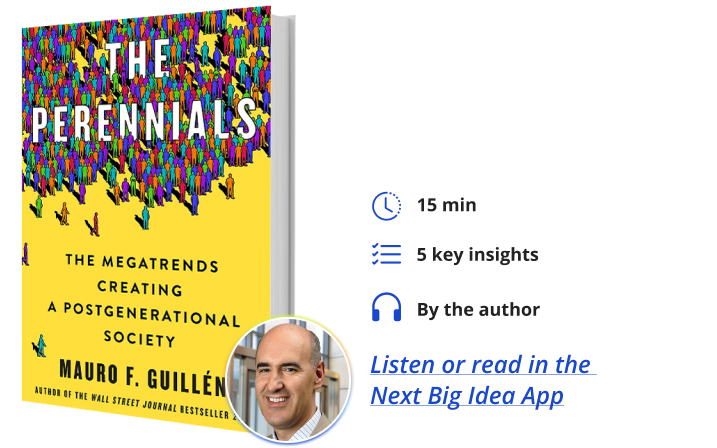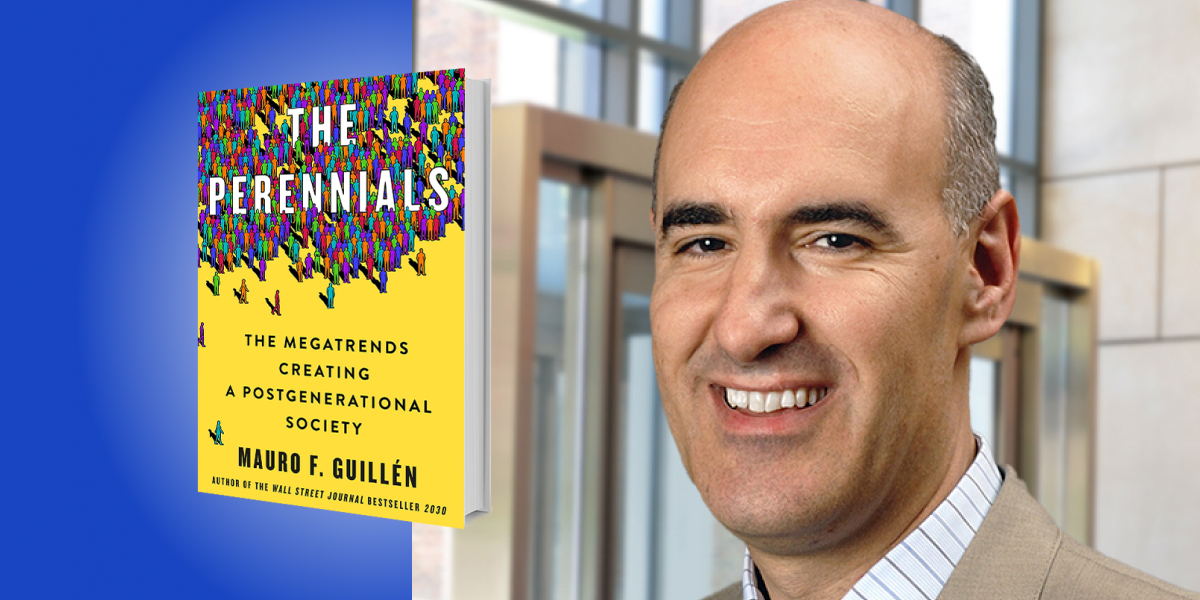Mauro Guillen is a sociologist and is currently the William H. Wurster Professor and a Vice Dean at the Wharton School of the University of Pennsylvania. He is a former Dean of Cambridge Judge Business School and was also a Guggenheim and Fulbright Fellow. He is the Wall Street Journal bestselling author of 2030: How Today’s Biggest Trends Will Collide and Reshape the Future of Everything.
Below, Mauro shares five key insights from his new book, The Perennials: The Megatrends Creating a Postgenerational Society. Listen to the audio version—read by Mauro himself—in the Next Big Idea App.

1. The future belongs to people above the age of 60.
Perennials are people who don’t think and act their age in the sense that they do not conform to conventional notions and stereotypes of young or old. People are increasingly eager to break away from traditional age stereotypes and expectations. This is happening in several realms of life, including living arrangements, education, and work. For example, we see more multi-generational households, teenagers becoming social rather than business entrepreneurs, people switching careers at midlife, younger people mentoring older employees, people of different ages learning together online, and retirees returning to work. These examples illustrate a perennial mindset whereby behavior is not nearly as driven by age as it has been since the dawn of a sequential model of life.
It may come across as counterintuitive but never has the future belonged to such an extent to people in the older age groups. A 60-year-old in the developed parts of the world can expect, on average, to live another 24 years. Moreover, they can often expect to be in good physical and mental health until they turn 78. For women, these numbers are higher by two to five years, depending on the country. Obviously, people aged 20 typically have more years to live, but the number of people in the younger age group is dropping relative to the number of people in the older age group. Everything is shifting towards the upper age groups: the workforce, consumption, and social and political influence.
“A perennial mindset at organizations and new technological developments should enable people beyond a certain age to access new, more flexible opportunities.”
In this context, retirement will be different. It will include more learning, freelancing, and flexible employment opportunities for seniors to help them with finances, boredom, and social isolation. In this way, there will be a better chance of having enough healthcare and pension resources to cover the needs of seniors, whether they work or not. Retirement in a post-generational world will be different than the classic retirement of the last century. While rest and leisure are very important, there is nothing preordained about needing to retire. While manual and cognitive occupations will be affected differently, most people will now have options to avoid some of the negatives of retirement.
A perennial mindset at organizations and new technological developments should enable people beyond a certain age to access new, more flexible opportunities. Remote work offers the possibility of avoiding any commuting. Artificial intelligence may make it easier for people to compensate for declining cognitive abilities while still leveraging their experience. Technology may also make freelancing more accessible. For manual labor, retraining programs might help them find virtual jobs as account supervisors or quality controllers. The universe of opportunities will be great for people who prefer to be active even after formally retiring.
2. The perennial mindset can reduce intergenerational friction.
The sequential model of life—with its rigid stages of play, learning, work, and retirement—multiplied and magnified intergenerational conflicts. Parents became the harshest critics of rebellious teenagers. Midlifers went through crises as they became dissatisfied with their lifestyle relative to younger people. Workers detested taxes to pay for healthcare and pensions, and retirees suffered from social isolation and loneliness after withdrawing from work. The best path to diminish the magnitude of these conflicts and achieve greater intergenerational understanding lies in helping people deviate from the sequential model of life.
Let me give you two examples. More people at advanced ages are now working, and that means there’s less of a tax burden on younger people and more opportunities for intergenerational interaction and collaboration in the multi-generational workplace. More people learning at different ages will also multiply points of contact between generations and help align their expectations.
3. The multi-generational household and workforce will transform the global economy.
Research shows that multi-generational households (if they become a more common living arrangement) will help reduce poverty levels, launch a revolution in residential real estate, facilitate caring for young children and people at advanced ages, reduce stress, and perhaps even reverse the decline in fertility given that young couples would feel more able to manage work and family under such an arrangement.
“The opportunities for two-way mentoring will be much greater.”
The multi-generational workplace will maximize productivity gains from having people with high levels of experience working side-by-side with younger people who are eager to grow professionally and are equipped with the latest knowledge. The opportunities for two-way mentoring will be much greater. Diverse teams are more creative and productive, and age can contribute to that diversity. Future problems with the financing of pension schemes might be overcome if more people work. And gross domestic product growth potential will also increase through this expansion of the active population.
4. A post-generational society will level the playing field in terms of access to essentials, like education, healthcare, employment, and housing.
We are very much prisoners to educational and work schemes of our own making, which are rampant with ageism: age prejudices, biases, and discrimination. A society driven by post-generational values and perennial mindsets will be able to leverage new ways of organizing, learning, and working (with the help of technological advancements) to level the playing field for all ages.
This will also help those who lose their turn in the sequential model of life when they either make the wrong decision, suffer an unlucky strike, or are pushed aside by circumstances—for instance, teenage mothers, recovering drug addicts, foster care children, high school dropouts, and middle-aged workers displaced by technological change. We presently don’t offer good ways of catching up. For instance, in the U.S. only 50 percent of teenage mothers graduated from high school and just two percent graduated from college.
5. In a post-generational world, work and careers will feel different.
People working in multi-generational settings, pursuing more than one career in their lifetime, taking several periods off to learn and re-skill—that is the world of tomorrow. Artificial intelligence tools and other communications technology will help people manage work, family, and leisure more flexibly. People working in multi-generational settings may create some friction, but it will also create opportunities for collaboration.
People should prepare themselves for these changes by developing skills that enable productive interactions with machines, as well as refine their social skills, negotiation, ability to work in teams, and emotional intelligence.
To listen to the audio version read by author Mauro Guillen, download the Next Big Idea App today:































